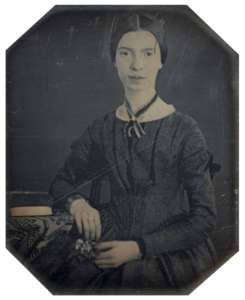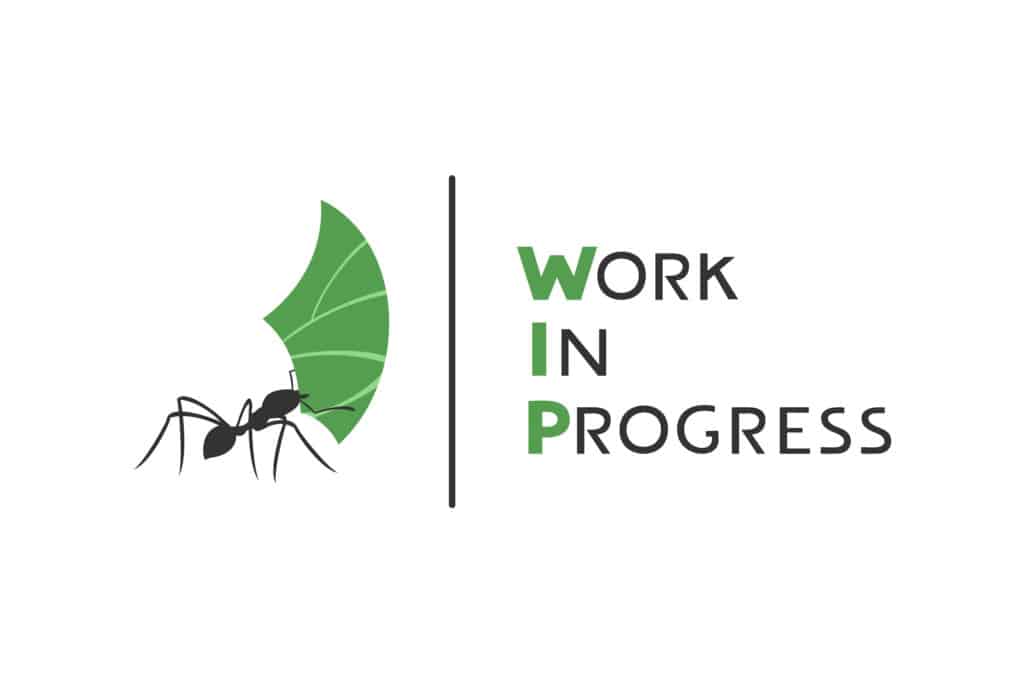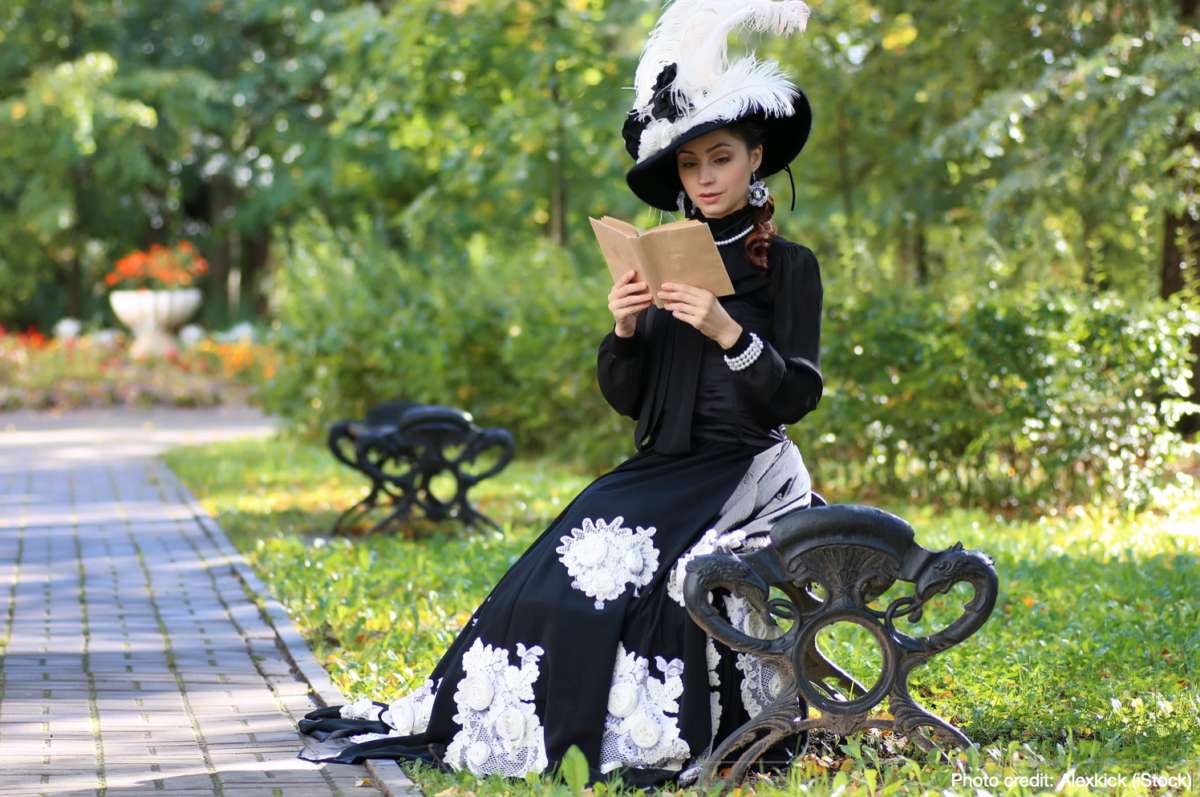I suppose I might have titled this post “Emily Dickinson: America’s Sweetheart” instead of “Sunshine and shade” and it would not be far from the truth. Incidentially, the woman on the feature photo is not Emily, but I wanted someone in period costume to suggest the age in which she lived and died (1830-1886.) The woman in the photo is not actress Cynthia Nixon, but she suffices.
Was Emily truly America’s Sweetheart? Perhaps not then, but certainly now. Among the many English majors I know who have written theses or dissertations, quite a few have chosen this reclusive New England poet as their research topic. I am neither an English major (else my posts would not be riddled with so many mixed metaphors, split infinitives or punctuation errors), nor am I well versed on this poet, but were it not for the present pandemic, I would have visited her lovely, home by now. It is near the top of my “bucket list” and I hope to journal about my visit to Amherst somedaw soon.
I enjoyed a number of Emily’s poems over the decades. “A Formal Feeling” is an example of one which I’ve shared with many of my students.
After great pain, a formal feeling comes –
The Nerves sit ceremonious, like Tombs –
The stiff Heart questions ‘was it He, that bore,’
And ‘Yesterday, or Centuries before’?
The Feet, mechanical, go round –
A Wooden way
Of Ground, or Air, or Ought –
Regardless grown,
A Quartz contentment, like a stone –
This is the Hour of Lead –
Remembered, if outlived,
As Freezing persons, recollect the Snow –
First – Chill – then Stupor – then the letting go –
Note the reference to Christ in the third line. My own wooden feet have taken me to that Hour of Lead that she warns us of, and I’ve experienced the chiil and stupor that follows the great pain. Only God’s grace and mercy kept me from letting go, but years later I can still recollect the snow and bitter cold. Poems like these resonate within me, and other poems such as “Had I Not Seen the Sun.”
To me, who is oblivious to her biography, her character, her challenges such as agoraphobia, her family and friendships, and her ill health–which ended somewhat earlier than it might had she not developed hypertension and congestive heart failure –“Had I Not Seen the Sun” suggests that she was a Christian and the shade was her former life. Now, she is living in the light of the Lord. But is that true? Could she have been speaking of something else when she wrote:
“Had I not seen the Sun
I could have borne the shade
But Light a newer Wilderness
My Wilderness has made—“
– Emily Dickinson Had I Not Seen the Sun (1233)
These verses also remind me of Plato’s Cave. In that scenario, people who knew only the present were content with the staus quo, until they broke their chains and saw reality in all it’s light, color and splendor. So, I decided to invest some time and research trying to come up with an understanding of what Emily says here and also how she viewed God, the Gospel, and her personal faith.
Gilbert Voigt writing in College English says:
“The chief thing about a [person] is [their] religion; and until we know what a [person] thinks and believes about religion and God, we don’t know that [person.]”
Voigt, Gilbert P. “The Inner Life of Emily Dickinson.” College English, vol. 3, no. 2, 1941, pp. 192–196. I’ve substituted Voight’s masculine pronouns in the quote to something more gender neutral.

Voight goes on to note “strange contradictions” and “startling inconsistencies” in Emily’s life (ibid.). These include her “cries of doubt” on the one hand and her “confessions of faith” on the other.
Emily Dickinson’s theology may be reduced to three dogmas, her creed to three articles. The first is her belief in the essential beauty and goodness of human life and of the earth. To this extent she was something of a pagan.”
Ibid, Voigt, Gilbert P. “The Inner Life of Emily Dickinson.”
He continues:
The second article of Emily Dickinson’s creed is the beneficent power of suffering. Although the sight of pain she could not relieve made of her “a demon,” yey she attempted to see the reason and the good in human suffering.”
Ibid, Voigt, Gilbert P. “The Inner Life of Emily Dickinson.”
Finally:
“The doctrine of original sin she held to be false. Of conversion she felt no need…As for the Bible, she accepted only those parts her experience confirmed.”
Ibid, Voigt, Gilbert P. “The Inner Life of Emily Dickinson.”
“The few short moments in which I loved my saviour I would not now exchange for a thousand worlds like this.”
– Emily Dickinson (1846)
In 1846, when Emily was 16, she “described herself as one who was fortunate to have experienced, if only briefly, a joy she took to be closely similar to that of conversion: ‘I think of the perfect happiness I experienced while I felt I was an heir of heaven as of a delightful dream, out of which the Evil one bid me wake and return to the world and its pleasures. Would that I had not listened to his winning words. The few short moments in which I loved my Saviour I would not now exchange for a thousand worlds like this. It was then my great pleasure to commune alone with the Great god and to feel that he would listen to my prayers.'” (Molson:406, 407.).
But, Molson points out elsewhere in his article that whatever amount of surrender Emily offered God was dependent on Him answering her prayers (possibly on the topics of friendships and true love) because she was assured as a child that he would. Her conversion (if that is what it truly was) took on the nature of a quid pro quo transaction which (at least in Emily’s mind) God did not honor. Thus, when God did not do her bidding, she hardened her heart to some degree and became bitter and angry with God. Emily was surrounded with death for most of her life and she seems to express a true fear of dying, herself and with what happens next. On the one hand, she willfully distances herself from God, while at the same time acknowledging her desire to spend eternity with HIm.
Molson wonder whether Emily’s problem with conversion was related to the need forced on her to “reject the world and it’s goodness” (418) or if it was more a case of a rebellious child–who as an adult–could not tolderate a father/daughter relationship. For much of her adult life, Emily vaccilated between longing for salvation and pouting over God, though she could never escape Him and mentioned Him frequently, for good or for bad, in her correspondence or her poems.
The best I can conclude is that Emily was raised in a traditional Christian home with fairly devote, stern parents (particularly her mother) and a pastor who was more like a Harry Emerson Fosdick than a Charles Finney. Her pastor assured her parents that “the usual process of conversion was not necessary for her.” Fortunately, much later in her life she met another pastor (Charles Wadsworth) who commanded more of Emily’s respect and confidence.
No doubt, her exposure to the Word at least while at home had some positive influence on her, but I learned that Emily was not easily “tamed” or brought into submission. Plus, she rebelled against the harsh, Calvinist doctrines such as election and moral depravity. Like Thomas Jefferson before her, she wished to pick and choose which passages of Scripture she liked and to ignore what she found to be unplesant or inconvenient. Perhaps she was remaking God in her image, even as she was made in His? In any event, her life seems to be something of a Greek tragedy. Someone with a better understanding of her might be able to connect the dots in a way that I cannot. On a rare trip away from Amherst, she did meet a Presbyterian minister in Philadelphia named Charles Wadsworth (mentioned above) who she cared deeply about. Who know what might have said between them concerning her faith in some correspodence, now lost to the ages? Only one letter of many survives to this day. We cannot know.
Women in her age and of her age were emerging from closeted lives to take their rightful place in society, and there were times when this influenced Emily. Finding conclusive or unambiguous statements about her faith in her poems and correspondence is something very illusive and does not seem to be present. Nor is there anything she ever wrote or said to the contrary. When she had doubts about God’s plan or His justice and mercy, she readily admitted and gave voice to them. But so might we in those same circumstances, and that is not necessarily sin. I wish I could be confident that even now she reposes in her heavenly Father’s arms, but that cannot be possibly known. If God’s love indeed covers a multitude of sins as the Apostle Peter assures us in his first epistle (4:8), sins such as rebellion, rejection and anger, then perhaps at long last Emily has found her True Love. And freedom from fear.
Citations
ARCHER, SETH. “‘I Had a Terror’: Emily Dickinson’s Demon.” Southwest Review, vol. 94, no. 2, 2009, pp. 255–273. JSTOR, www.jstor.org/stable/43472987.
Harde, Roxanne. “‘Some—Are like My Own—”: Emily Dickinson’s Christology of Embodiment.” Christianity and Literature, vol. 53, no. 3, 2004, pp. 315–336. JSTOR, www.jstor.org/stable/44313322.
Molson, Francis J. “Emily Dickinson’s Rejection of the Heavenly Father.” The New England Quarterly, vol. 47, no. 3, 1974, pp. 404–426. JSTOR, www.jstor.org/stable/364379.
Voigt, Gilbert P. “The Inner Life of Emily Dickinson.” College English, vol. 3, no. 2, 1941, pp. 192–196. JSTOR, www.jstor.org/stable/370816.





